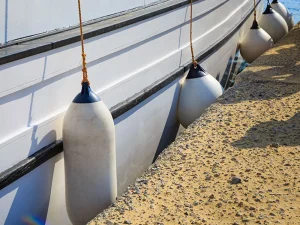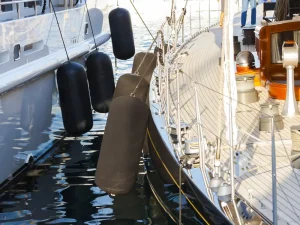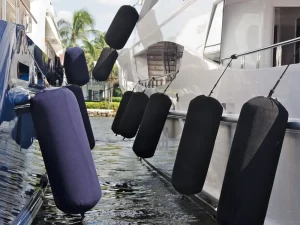Boating fenders are excellent accessories that have been used for many decades. They protect the boats from damage during collisions. However, they can only do their job effectively when deployed at the right time. Right? This brings a question: when should you put fenders on your boat?
This question looks simple; the answer is like when you’re about to dock. Right? But that’s not the complete answer. There are many scenarios where you should put the fenders on a boat. In case of negligence, boats can face severe impacts. In this article, I’ll explore all those possible scenarios where you should be ready to put fenders. Let’s get started!
Overview of Boat Fenders

Boat fenders are small additional accessories that protect the boat from impacts. They are made of rubber and can effectively absorb shocks. Boats generally can collide with docking structures or with other ships. These fenders hang around the boat and absorb the impact of the collision, ensuring the boat remains safe.
Boats undergo different collisions during docking, anchoring, or mooring. Remember, boats travel at some speed. If they collide with any structure at speed, they can get damaged. Even if the boat is not at high speed, minor collisions can still dent the boat. Ultimately, this will affect the durability and longevity of the boat.
In such cases, the fenders come in handy. They are small inflated rubber accessories that hang around the boat. When a boat comes close to any structure, it does not directly collide with that structure. Instead, the fenders first touch or collide with that structure. They absorb the impact force and do not allow the impact to affect the boat itself.
In this way, boats remain safe and stable, and they do not face a big jerk. You might ask: Are boat fenders the same as vessel fenders? The answer is YES. Their function and work are the same: to protect the ship. However, the boat fenders are smaller in size. The vessel fenders are huge and consist of several meters in diameter or length.
When Should You Put Fenders on Your Boat?

Let’s begin with a short answer before going into different scenarios.
You should put fenders on the boat when you notice any chance of collision. The collision can be between a boat and another boat or a docking structure. Once you put fenders on the boat, they will safeguard it, no matter how harshly a collision occurs. Fenders will serve their purpose, i.e., absorbing the impact (force).
That is the most straightforward answer. Will you always be active and anticipate the chances of collisions? The answer is NO! There are many scenarios where you should always put fenders. This way, you won’t have to check and guess if there is a chance of collision. In the section below, I will discuss those scenarios and occasions where you must put the fenders.
1- Docking
Docking is moving or maneuvering the boat to dock or pilings. It is then tied up and stays in one place. Remember, docks consist of docking structures. The ship can collide with these structures. When you are docking, you must put the fenders on the boat. It will ensure the boat does not collide directly with the docking structure.
The fenders collide first instead of the boat when close to the docking structure. As a result, the fenders will absorb the impact, saving the ship. Remember, other vessels can also be present at the dock. Your boat can also collide with those nearby boats or ships. Therefore, putting a fender is mandatory during docking.
2- Mooring
Mooring is similar to docking but is not limited to only docks. Instead, mooring is a process that can be applied anywhere in the water body or docks. For example, you can use mooring to anchor your boat. You can also moor your boat with any other ship. There are different types of mooring available.
When mooring, your boat comes close to either an anchor point or another ship. The mooring line keeps the ship floating on the water’s surface at one point. There are chances of collision during mooring. Therefore, it is highly recommended to use boat fenders to ensure the safety of your boat. During mooring, the boat keeps moving slightly. Having fenders ensures it remains safe if the boat moves or hits anything.
3- When Tying Up Alongside Another Vessel (Rafting)

Let’s first discuss rafting.
Rafting is the arrangement of boats side by side to ensure many boats can stay in less space. This is generally common on docking points with lesser docking space. Moreover, the athletes also use rafting to ensure their boats are alongside each other. You should put fenders on your boat when facing rafting.
In the past, there was less marine traffic, and docks easily accommodated ships. However, many boats and ships have entered, putting more pressure on docking structures. On busy docks, people have to tie their boats alongside other ships. In this way, more boats can stay and take less docking space.
As the boats are close together, their chances of collision are higher. In windy weather or tides, these boats make slight movement. As a result, they collide. When you are tying up your boat along another, put the fenders on it. If your ship collides with any other, it won’t get any dent. The fender will bear the force of impact, ensuring the safety of your boat.
4- Passing Through Narrow Pathway
Maneuvering boats in narrow channels or crowded marinas requires a skill set. A slight mistake can cause a collision of your boat with another. In such a case, having a fender on the boat is a wise decision. Marinas generally have lots of boats, ships, and yachts.
When entering the marina, I recommend putting fenders on your boat. The situation can become worse when the wind is fast. The water wave can imbalance your boat, increasing the chances of collision. So, having a fender on a boat will give you peace of mind in case of unintentional contact or collision.
5- During Anchoring in Tight Spaces
Generally, the boaters enjoy a larger anchorage area. You don’t need to put the fenders if you are anchoring at a large anchorage area. More area in the anchorage point will keep all the boats safe from each other. However, some anchorage points have a small area or space. Boaters have to anchor their ships close together in such cases.
I highly recommend putting a fender on your boat if you’re at such an anchorage point. All the boats are very close, and the wind and water waves can make your boat move and hit the nearby boat. Your boat will get dented or scratched if it does not have fenders. Remember that water tides and wind play key roles in such scenarios.
6- Passing Through Locks
Locks are chambers on waterways that help boats and ships travel through different (dangerous) water levels. They ensure the safety of the ships by ensuring they remain level water. The ships or boats pass through the locks consisting of two walls. Some locks are wider, and boats can easily pass through those. The chances of collision are very low.
However, some locks are narrow due to limited space. In such cases, a slight imbalance in the boat can cause collusion between the boat and the lock wall. Therefore, I recommend putting fenders on the boat when passing through locks. In a collision with a lock wall, the fenders will absorb the impact. In this way, the boat will remain safe, and passengers won’t feel jerks.
How to Use Boat Fenders Properly?
In the section above, I mentioned the scenarios where you should put a fender on a boat. However, I’ve noticed that many people don’t have Fender installation guidance. As a result, they put them in the wrong way, affecting fenders’ functionality. Let’s dive down and discuss the things that you must consider when using boat fenders:
- First, choose the size of the fender that fits your boat. Different sizes of fenders are available, and they are suitable for various boat sizes. Small boats will use small fender sizes, and vice versa. Remember, fender sizes vary depending on the size of the boats. Boats of 10 feet in size should use 3 to 5-inch fenders. Fenders with diameters of 6–8 inches are suitable for boats of 25 to 30 feet in size.
- You should check the position of the fender. It should come in a position that makes contact with the docking structure. For example, you should put them along the hull as it first makes contact with the docks. In rafting, put them on sides that can contact other boats.
- Putting the fender at the right height is paramount. Remember, mounting the fender above the docking structure is useless. It won’t collide with the dock, so the dock will directly collide with the boat. I recommend you keep the fender at the dock level. In this way, the fender will collide with the dock instead of the boat.
- When mounting the fender, ensure that the fender doesn’t move. Generally, tides and water waves can make boats dance on water. If fenders are loose, they are more likely to move away from their position. So, upon collision, they won’t be able to work effectively. You should secure them tightly with rope to ensure they remain stable.
Conclusion
Boats of different sizes are available in the marine world. Boaters ignore the importance of fenders and end up with scratches or dents on their boats. Fenders are like bumps; they can save a boat even in harsh collisions.
In this article, I will explain key scenarios for using boat fenders. In case of negligence, you might end up facing a collision. If you don’t know how to use boat fenders, fret not! I’ve explained the usage of fenders and indicated the key points to avoid mishaps.
